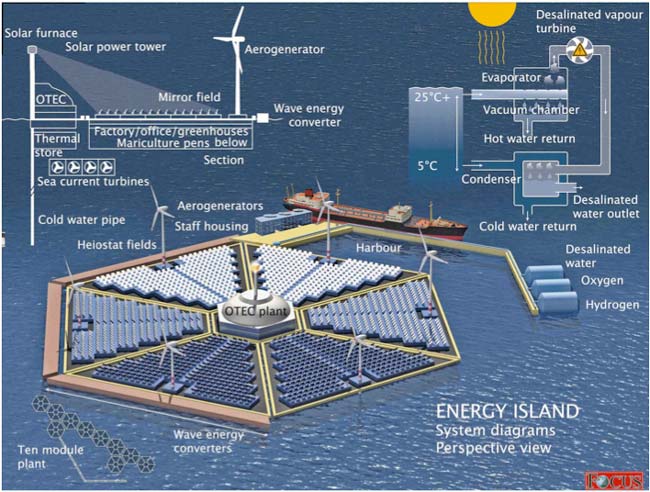How Floating 'Energy Islands' Could Power the Future

Editor's Note: Each Wednesday LiveScience examines the viability of emerging energy technologies — the power of the future.
The ocean harbors abundant energy in the form of wind, waves and sun. All of these could be sampled on something called an Energy Island: a floating rig that drills for renewables instead of petroleum.
The concept is the brainchild of inventor Dominic Michaelis. He was originally unsatisfied with the slow progress in developing ocean thermal energy conversion (OTEC), a process in which cold water is pumped up from the deep ocean to generate electricity.
"Nothing new was happening with OTEC, so I thought why not bring other marine energy technologies on board?" Michaelis said.
The Energy Island that he and his son have designed would have an OTEC plant at its center, but spread across the 2,000-foot-wide (600-meter-wide) platform would also be wind turbines and solar collectors. Additionally, wave energy converters and sea current turbines would capture energy from water moving around the structure.
One of these hexagonally-shaped islands could generate 250 megawatts (enough power for a small city), Michaelis said. Even more power is possible by mooring together several Energy Islands into a small archipelago that could include greenhouses for food, a small harbor for ships and a hotel for tourists.
To attract possible investors, the Energy Island team will present their concept this week at the U.S. China GreenTech Summit in Shanghai.
Get the world’s most fascinating discoveries delivered straight to your inbox.
Running hot and cold
The principle reason to build an Energy Island is to harvest OTEC.
"The advantage of OTEC over other marine energy technologies is that it's constant, 24 hours a day and all year round," Michaelis told LiveScience.
This is because it is based not on the sun or the wind or the waves, but on the temperature difference between warm water at the sun-heated surface and cold water in the deep, dark ocean.
The biggest temperature differences can be found in tropical seas, where the surface water is around 80 degrees Fahrenheit (25 degrees Celsius).
This warm water is drawn in from around the Energy Island and used to evaporate a working fluid, which might be seawater or ammonia. The resulting vapor pushes a turbine that produces electricity.
To condense the vapor back to fluid, cold water at about 40 degrees Fahrenheit (5 degrees Celsius) is pumped up from a half mile below the surface. This condensation creates a pressure drop that helps suck more vapor through the turbine blades.
The same basic process occurs in a coal-fired or nuclear power plant, but the temperature difference between water boilers and cooling towers is much greater than in an OTEC system.
Large overhead
The first OTEC plant was built in 1930 on a Cuban shoreline and produced 22 kilowatts of power. Only a handful of other facilities (both floating and land-based) have been constructed since, with the largest being a 250-kilowatt pilot plant in Hawaii. None are currently operating.
The main drawback has been the inherent inefficiency of converting a relatively small temperature difference into electricity. In fact, some of the early OTEC designs used more energy than they were able to produce.
An OTEC plant requires a lot of energy to circulate massive amounts of water. The Energy Island, for example, will need more than 100,000 gallons (400 cubic meters) of cold water pumped up per second.
This is why Michaelis incorporates other marine energy technologies to help "prime" the OTEC system.
Fringe benefits
The clean power generated by an Energy Island could be transmitted to shore by underwater cables. Or it could be used to make hydrogen from water, and this hydrogen fuel could be shipped to the mainland in order to produce electricity in fuel cells.
The exported electricity might run 9 to 13 cents per kilowatt-hour, depending on how the project is financed, Michaelis said. A single Energy Island has an estimated price tag of $600 million.
However, electricity is not the only thing these man-made isles can offer.
If seawater is used as the OTEC working fluid, it will be desalinated through the cycle of evaporation and condensation. For each megawatt of electricity produced, an OTEC plant can supply 300,000 gallons of fresh water per day, Michaelis said.
Moreover, the cold water pumped up from the ocean depths is full of nutrients that could support fish farms or some other form of aquaculture.
- Top 10 Craziest Environmental Ideas
- Video - On Dancing Air: The Story of Wind Power
- World Needs a Backup Plan
 Live Science Plus
Live Science Plus






